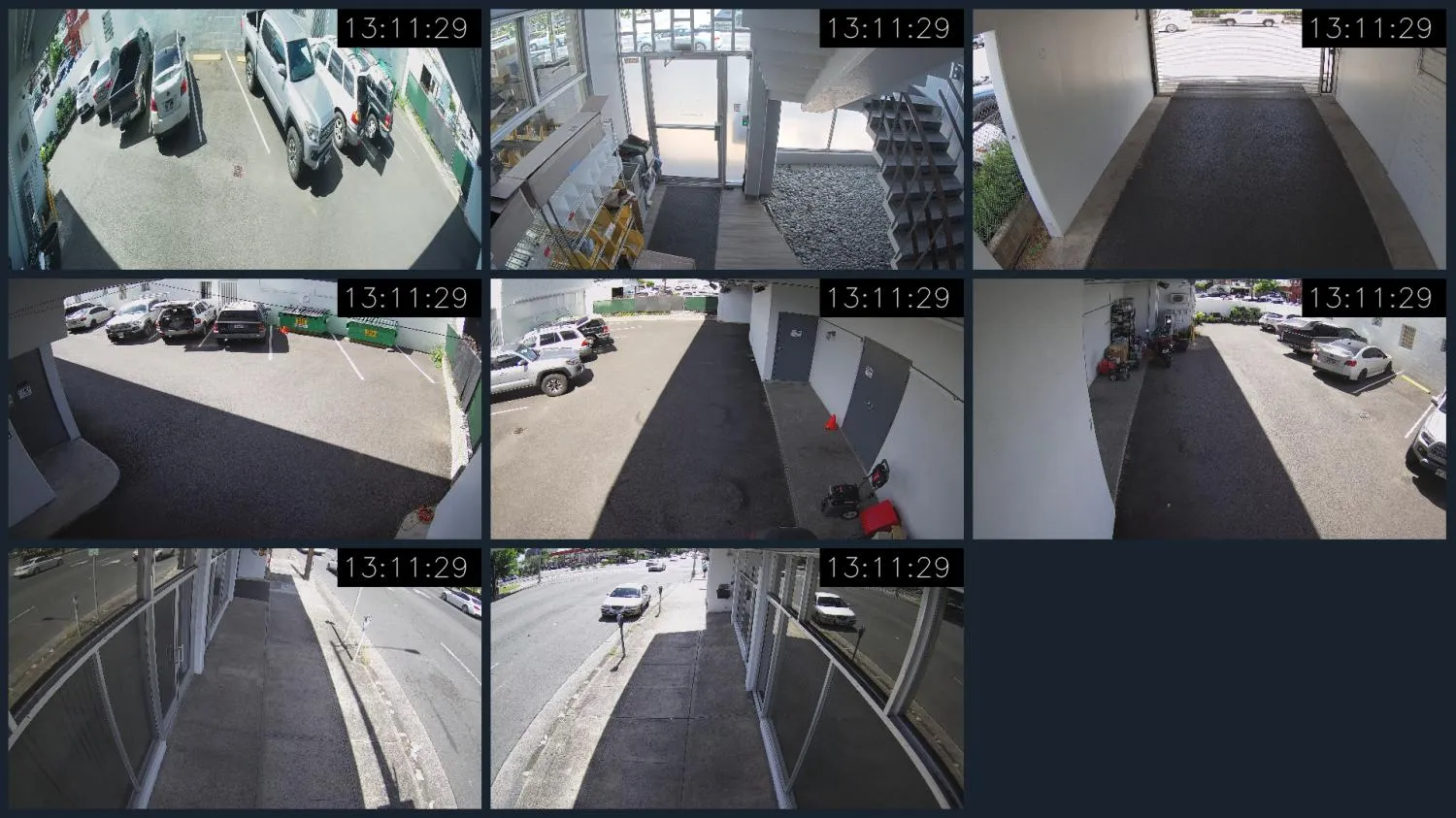
为了捕获多个流,建议使用线程来缓解重 I/O 操作的压力并提高性能。由于使用 cv2.VideoCapture().read() 访问摄像机/IP/RTSP 流是一种阻塞操作,主程序将一直等待直到从相机设备读取帧。如果您有多个流,则此延迟肯定会可见。为解决这个问题,我们可以使用线程来生成另一个线程,在并行使用 deque 处理获取帧而不是依靠单个线程按顺序获取帧。线程允许连续读取帧而不影响主程序的性能。使用线程和 OpenCV 捕获单个流的想法来自于之前在Python OpenCV multithreading streaming from camera的回答。
但是,如果您想捕获多个流,仅使用 OpenCV 是不够的。您可以使用 OpenCV 结合 GUI 框架来将每个图像拼接到漂亮的显示器上。我将使用PyQt4作为框架,qdarkstyle为 GUI CSS,imutils为 OpenCV 的便利函数。
这是我当前使用的摄像机 GUI 的简化版本,其中没有占位图像、凭据管理员登录页面和切换摄像机功能。如果您想添加另一个摄像头,那么它非常简单,并且不会影响性能。此摄像机 GUI 当前以约 ~60 FPS 运行,因此是实时的。您可以使用 PyQt 布局轻松重新排列布局,因此请随意修改代码!记得更改流链接!
from PyQt4 import QtCore, QtGui
import qdarkstyle
from threading import Thread
from collections import deque
from datetime import datetime
import time
import sys
import cv2
import imutils
class CameraWidget(QtGui.QWidget):
"""Independent camera feed
Uses threading to grab IP camera frames in the background
@param width - Width of the video frame
@param height - Height of the video frame
@param stream_link - IP/RTSP/Webcam link
@param aspect_ratio - Whether to maintain frame aspect ratio or force into fraame
"""
def __init__(self, width, height, stream_link=0, aspect_ratio=False, parent=None, deque_size=1):
super(CameraWidget, self).__init__(parent)
self.deque = deque(maxlen=deque_size)
self.offset = 16
self.screen_width = width - self.offset
self.screen_height = height - self.offset
self.maintain_aspect_ratio = aspect_ratio
self.camera_stream_link = stream_link
self.online = False
self.capture = None
self.video_frame = QtGui.QLabel()
self.load_network_stream()
self.get_frame_thread = Thread(target=self.get_frame, args=())
self.get_frame_thread.daemon = True
self.get_frame_thread.start()
self.timer = QtCore.QTimer()
self.timer.timeout.connect(self.set_frame)
self.timer.start(.5)
print('Started camera: {}'.format(self.camera_stream_link))
def load_network_stream(self):
"""Verifies stream link and open new stream if valid"""
def load_network_stream_thread():
if self.verify_network_stream(self.camera_stream_link):
self.capture = cv2.VideoCapture(self.camera_stream_link)
self.online = True
self.load_stream_thread = Thread(target=load_network_stream_thread, args=())
self.load_stream_thread.daemon = True
self.load_stream_thread.start()
def verify_network_stream(self, link):
"""Attempts to receive a frame from given link"""
cap = cv2.VideoCapture(link)
if not cap.isOpened():
return False
cap.release()
return True
def get_frame(self):
"""Reads frame, resizes, and converts image to pixmap"""
while True:
try:
if self.capture.isOpened() and self.online:
status, frame = self.capture.read()
if status:
self.deque.append(frame)
else:
self.capture.release()
self.online = False
else:
print('attempting to reconnect', self.camera_stream_link)
self.load_network_stream()
self.spin(2)
self.spin(.001)
except AttributeError:
pass
def spin(self, seconds):
"""Pause for set amount of seconds, replaces time.sleep so program doesnt stall"""
time_end = time.time() + seconds
while time.time() < time_end:
QtGui.QApplication.processEvents()
def set_frame(self):
"""Sets pixmap image to video frame"""
if not self.online:
self.spin(1)
return
if self.deque and self.online:
frame = self.deque[-1]
if self.maintain_aspect_ratio:
self.frame = imutils.resize(frame, width=self.screen_width)
else:
self.frame = cv2.resize(frame, (self.screen_width, self.screen_height))
cv2.rectangle(self.frame, (self.screen_width-190,0), (self.screen_width,50), color=(0,0,0), thickness=-1)
cv2.putText(self.frame, datetime.now().strftime('%H:%M:%S'), (self.screen_width-185,37), cv2.FONT_HERSHEY_SIMPLEX, 1.2, (255,255,255), lineType=cv2.LINE_AA)
self.img = QtGui.QImage(self.frame, self.frame.shape[1], self.frame.shape[0], QtGui.QImage.Format_RGB888).rgbSwapped()
self.pix = QtGui.QPixmap.fromImage(self.img)
self.video_frame.setPixmap(self.pix)
def get_video_frame(self):
return self.video_frame
def exit_application():
"""Exit program event handler"""
sys.exit(1)
if __name__ == '__main__':
app = QtGui.QApplication([])
app.setStyleSheet(qdarkstyle.load_stylesheet_pyqt())
app.setStyle(QtGui.QStyleFactory.create("Cleanlooks"))
mw = QtGui.QMainWindow()
mw.setWindowTitle('Camera GUI')
mw.setWindowFlags(QtCore.Qt.FramelessWindowHint)
cw = QtGui.QWidget()
ml = QtGui.QGridLayout()
cw.setLayout(ml)
mw.setCentralWidget(cw)
mw.showMaximized()
screen_width = QtGui.QApplication.desktop().screenGeometry().width()
screen_height = QtGui.QApplication.desktop().screenGeometry().height()
username = 'Your camera username!'
password = 'Your camera password!'
camera0 = 'rtsp://{}:{}@192.168.1.43:554/cam/realmonitor?channel=1&subtype=0'.format(username, password)
camera1 = 'rtsp://{}:{}@192.168.1.45/axis-media/media.amp'.format(username, password)
camera2 = 'rtsp://{}:{}@192.168.1.47:554/cam/realmonitor?channel=1&subtype=0'.format(username, password)
camera3 = 'rtsp://{}:{}@192.168.1.40:554/cam/realmonitor?channel=1&subtype=0'.format(username, password)
camera4 = 'rtsp://{}:{}@192.168.1.44:554/cam/realmonitor?channel=1&subtype=0'.format(username, password)
camera5 = 'rtsp://{}:{}@192.168.1.42:554/cam/realmonitor?channel=1&subtype=0'.format(username, password)
camera6 = 'rtsp://{}:{}@192.168.1.46:554/cam/realmonitor?channel=1&subtype=0'.format(username, password)
camera7 = 'rtsp://{}:{}@192.168.1.41:554/cam/realmonitor?channel=1&subtype=0'.format(username, password)
print('Creating Camera Widgets...')
zero = CameraWidget(screen_width//3, screen_height//3, camera0)
one = CameraWidget(screen_width//3, screen_height//3, camera1)
two = CameraWidget(screen_width//3, screen_height//3, camera2)
three = CameraWidget(screen_width//3, screen_height//3, camera3)
four = CameraWidget(screen_width//3, screen_height//3, camera4)
five = CameraWidget(screen_width//3, screen_height//3, camera5)
six = CameraWidget(screen_width//3, screen_height//3, camera6)
seven = CameraWidget(screen_width//3, screen_height//3, camera7)
print('Adding widgets to layout...')
ml.addWidget(zero.get_video_frame(),0,0,1,1)
ml.addWidget(one.get_video_frame(),0,1,1,1)
ml.addWidget(two.get_video_frame(),0,2,1,1)
ml.addWidget(three.get_video_frame(),1,0,1,1)
ml.addWidget(four.get_video_frame(),1,1,1,1)
ml.addWidget(five.get_video_frame(),1,2,1,1)
ml.addWidget(six.get_video_frame(),2,0,1,1)
ml.addWidget(seven.get_video_frame(),2,1,1,1)
print('Verifying camera credentials...')
mw.show()
QtGui.QShortcut(QtGui.QKeySequence('Ctrl+Q'), mw, exit_application)
if(sys.flags.interactive != 1) or not hasattr(QtCore, 'PYQT_VERSION'):
QtGui.QApplication.instance().exec_()
涉及摄像头/IP/RTSP、FPS、视频、线程和多进程的内容,参考以下帖子:
Python OpenCV 从摄像头流式传输 - 多线程、时间戳
使用OpenCV cv2.VideoCapture在Python中从IP摄像头进行视频流传输
如何使用OpenCV捕获多个摄像头流?
OpenCV实时视频流捕获缓慢。如何丢弃帧或与实时同步?
使用OpenCV VideoWriter将RTSP流存储为视频文件
OpenCV视频保存
Python OpenCV 多进程 cv2.VideoCapture mp4

else块中,它将永远尝试寻找相机,不应该放弃。这是否与你调用的spin函数有关? - Voldemort